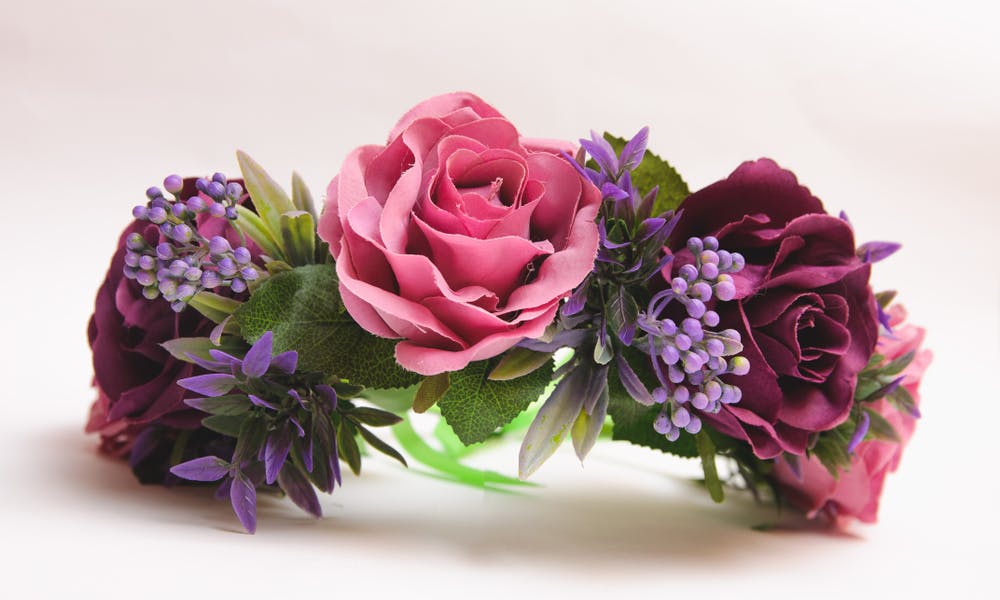MENU
How to Make A Flower Crown for Every Occasion

At a first glance, making a flower crown is very simple. The easiest part is to attach some beautiful flowers around the support of your choice and the crown is ready. The difficult part of making flower crowns comes when you realize that you have many options, that are full of potential, and you do not know what flowers to choose or how to arrange them.
Below, we show you the most important aspects you need to know about making flower crowns so that you make the best choices when you start such a creative project:
* How to choose the flower crown support
* Which are the most suitable colors and flowers for the flower crown
* How to choose the right bow
How to Choose the Flower Crown Support
For the crown support, you could use floral wire, foam, sponge (for cut flowers), moss, or straw. The flowers can be attached to the base either with a soldering gun or with fasteners. However, in this case, you can choose among paper, cotton, velvet or special wire in order to achieve a beautiful flower crown. There are so many reasons that you can make a flower crown. Whether it is a crown for the end of the school year or a project to do with your children, they are easy and affordable. Also, you can make a decorative crown from fir branches or dried flowers, from objects around your yard or in your garden.
You should think ahead about the role the respective crown is playing and the place where it should be located. For example, if you are preparing to make a decorative crown for a wall, it may receive a lot of natural light and may fade quickly.
Foamflower supports are accessible and available in a variety of sizes and shapes. Their disadvantage is that the appearance of the crown may suffer if you do not cover each portion of foam well. Also, on the foam, you may experience some difficulties. For example, if you use glue (some types of glue do not adhere well to its surface, others may melt). Therefore, to avoid such problems, you can wrap the base of the foam, fixing it with needles.
Floral wire support is ideal when working with light materials, such as dried flowers or goose willow (Salix caprea). These come in a range of wire bases. They are ideal if you want to create full, bulky decorative crowns. The flowers are fastened on the wireframe with the floral wire, and the petals or leaves can be attached with glue to the natural materials from the crown.
Wool support is a good choice all year round for several types of crowns. If portions remain uncovered, it is not a problem because it integrates well into the appearance of a flower crown. To attach flowers and other materials to a wool support, you can use glue or floral wire.
If you use flowers that are light in color, it creates a beautiful, eye-popping contrast that looks exquisite on anyone. On the other hand, there are very beautiful crowns made with flowers and accessories of intense colors.
Which Are the Most Suitable Colors and Flowers for The Flower Crown
To keep the flowers fresher longer, you should use flexible vials that are fastened in the support and provide the necessary moisture for the stem. You can include both fresh and dried flowers, berries (small and colorful fruits of certain shrubs), dried fruits (apples, lemons, pomegranates), aniseed stars, fir cones, and cinnamon sticks. Specific crowns that designed for a certain season can be topped with bows and other accessories to accentuate a time of the year.
To find colors that harmonize, try to familiarize yourself with the color wheel. The complementary colors, for example, are opposite on the color wheel (red-green, yellow-purple, yellow-blue) create a strong contrast. The analogous ones arranged next to the wheel (for example, yellow, dark yellow, orange, red), have a restful effect on the eye because it realizes a gradual transition from one shade to another.
The crowns can be used for different occasions: such as weddings, all types of parties and celebrations, at a Christmas dinner, or any other get-together. Also, young girls can spice up their regular headbands with natural flowers. A crown made from natural flowers is a romantic, original and very elegant choice for any bride. Moreover, they fit any hairstyle.
For weddings, the most suitable flowers for a crown are those that match her bouquet and theme. Roses, carnations, mini roses, lavender or crowns made from combinations of field flowers are often found at occasions like weddings, graduations, or baby showers. Summer headbands can be made from crimson flowers or natural flower blends with cotton flowers.
At Christmas, the crowns are generally made of orchids, poinsettias, amaryllis, lily, and mist. This crown is made for the front door and often used by families with many children. It should necessarily contain natural fir branches and ornaments, balloons, bells, fir cones, red bows, and lots of polish.
How to Choose the Right Bow
A truly spectacular flower wreath must include a bow. Cotton and paper bows are best if you don’t have much experience in making a flower crown. The velvet bows give the crown a traditional and sophisticated look, while the raffia bows seem more natural and unpretentious. The colored cellophane bow has a festive air, and the lace one is suitable for weddings and other special occasions.
All in all, making a flower crown is a straightforward task, but it is important to choose the right flowers and colors to create the most suitable decor. Whether you are preparing for a wedding, a birthday party, or you simply want to beautify your home or your garden, a flower crown might be right what you need.

